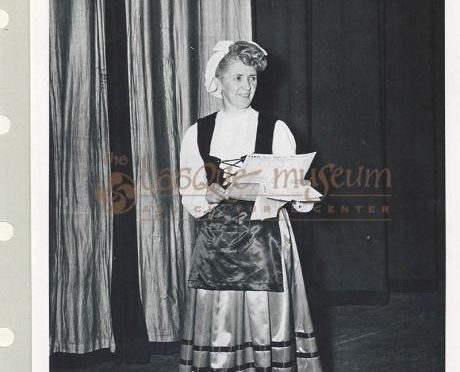When going to Basque festivals or summer dinners, we often forget the effort and dedication that goes on behind the scenes. Even the most cherished traditions – such as the Oinkari Basque Dancers – had to start somewhere and sometimes those ideas are met with resistance. It’s so important to have those individuals that not only devote their time and energy to such endeavors, but are the spark that catalyze something bigger. Jay Uberuaga Hormaechea was one of those sparks, leaving an indelible mark on the Basque community of Boise and beyond.

- Jay was born on October 14, 1908, in the family’s boarding house in Boise, Idaho. She was one of seven children. Her parents, Juana Arriola and Juan Uberuaga, were immigrants from the Basque Country. Juana was from Mutriku, Gipuzkoa while Juan was from Munitibar (he was the brother of my great-grandfather). Both worked extremely hard. Juan delivered coal and worked as a night watchman. During Prohibition, Juana sold bootleg whisky. At home, the first language was Basque.
- By the time she was thirteen, Jay began working in other boarding houses as a maid. At these boarding houses, she worked hard, but she also danced every day. She also worked at some of the local stores, acting as a Basque interpreter. In 1937, she graduated from the State Beauty College and began working at the Whitehead Beauty Salon, owned by Ruth Yturri. She later purchased the salon and ran the business for another 48 years.
- There were many firsts in Jay’s contributions to the Basque community of Boise. For example, in 1936, in an effort to bolster the Basque culture in the region, she helped create the Basque Girls Knitting Club. She was a founding member of Euzkaldunak Incorporated and the Basque Girl’s Club. She was the first elected delegate of Euzkaldunak to the North American Basque Organizations. She was the first woman inducted into the Society of Basque Studies in America’s Hall of Fame.
- Perhaps most important, Jay was the first to teach traditional Basque dance in the United States. Her first formal classes started in 1947, with Jimmy Jausoro and Domingo Ansotegui providing music. Her first performance was in 1948 during Music Week in Boise. That same year, she helped found the Heritage School of Basque Dancing. At first, there was resistance from the local Basque community as they questioned who she was to teach dance and that her efforts would bring embarrassment to the community. However, dance brought them together like they hadn’t been before. Ultimately, her efforts laid the foundation for what would become the Oinkari Basque Dancers.
- Jay died on May 9, 1997.
A full list of all of Buber’s Basque Facts of the Week can be found in the Archive.
Primary sources: Juanita “Jay” (Uberuaga) Hormaechea, the Basque Museum and Cultural Center; Totoricagüena Egurrola, Gloria Pilar. HORMAECHEA UBERUAGA, Juanita. Auñamendi Encyclopedia. Available at: https://aunamendi.eusko-ikaskuntza.eus/en/hormaechea-uberuaga-juanita/ar-52032/



Greetings,
why was there resistance from the Basque community? What set the Basques apart from the rest of Europe centuries ago was the fact that the first born, male or female, would inherit the family properties –of course, with the moral obligation to look after the siblings. It may have been written in the fueros.
Good for her!!!
Monique